Resorbable polymer composition, implant and method of making implant
a polymer composition and polymer technology, applied in the field of new implants, can solve the problems of difficult delivery of a correct dose of bmps, poor understanding of the whole bone healing process, and high cost of bmps produced by genetic engineering
- Summary
- Abstract
- Description
- Claims
- Application Information
AI Technical Summary
Benefits of technology
Problems solved by technology
Method used
Image
Examples
example 1
[0024]Polylactide / Polyglycolide / Trimethylene carbonate copolymer (PLA / PGA / TMC), with a composition of 80 / 10 / 10, granulates were compression moulded to form a film with a thickness of 0.2 mm. Used compression temperature was 180° C. and pressure 130 bar. From the film 10 rectangular pieces were cut, each with a width of 20 mm.
[0025]The weight of the individual film pieces were measured with balance with an accuracy of 1 mg. The film pieces were then immersed individually into NMP for 30 seconds. After immersion the film pieces were air dried for 20 minutes and the weight of the pieces was measured again.
[0026]The weight of the film pieces before and after immersion into NMP are shown in table 1. The average amount of NMP diffused into polymeric film was 44.19%.
[0027]
TABLE 1The weight of the film pieces before and after immersion into NMPWeight beforeWeight afterNMPPolymerNMPimmersion intoimmersion intocontentcontentcontentNMP (mg)NMP (mg)(mg)(%)(%)56.4198.9542.5457.0142.9967.29115.40...
example 2
[0029]This rabbit study shows the osteogenetic effect of PLA / PGA / TMC and PLDLA / PLA / TMC membranes when treated with NMP. The details of the tested membranes can be found in the following table 2.
[0030]
TABLE 2Materials and codes of example 2CodeMaterialsE1M-11 NMPPLA / PGA / TMC (80 / 10 / 10), treated with NMP(see EXAMPLE 1)E1M-11PLA / PGA / TMC (80 / 10 / 10)E1M-3 NMPPLDLA / PLA / TMC (55 / 40 / 5), treated with NMP(as in EXAMPLE 1)E1M-3PLDLA / PLA / TMC (55 / 40 / 5)OsseoQuestPLA / PGA / TMC supplierW. L. GORE & Associates, Inc.E1M-11 withPLA / PGA / TMC (80 / 10 / 10), with holes manufacturedholesusing LaserTMC / PLAPLA / TMC (70 / 30)
[0031]The study design included eight rabbits with four 6-mm artificial craniotomy defects each. The defects were treated with biodegradable membranes and a commercial biodegradable OsseoQuest membrane as shown in table 2. Controls treated without any membranes were included, too. The matrixes of the resorbable membranes are also presented in table 2.
[0032]The rabbits were sacrificed 4 weeks after t...
example 3
[0037]According to one embodiment of the method of the present invention, NMP is added to the polymer matrix that has been already fashioned into the form of a medical implant.
[0038]Polymer compositions were prepared by dry-mixing commercially available granular-form base materials with commercially available copolymer additives. The material composition was 80 wt-% P(L / DL)LA (70 / 30) and 20 wt-% PLLA / TMC (70 / 30). The components were weighed according to a desired weight ratio into a container which was then rotated in a Turbula T2F shaker mixer for 30 minutes until a homogenous dry mixture was obtained. The resulting mixture was then dried in vacuum at 60° C. for 8 to 12 hours and thereafter melt-blended and injection-moulded in to plate-shaped test pieces. The injection-moulding machine used was a fully electric Fanuc Roboshot Alpha i30A injection-moulding machine with a mould clamping force of 300 kN. The injection unit was equipped with high speed (max. 66 cm3 / s to 330 mm / s), hig...
PUM
| Property | Measurement | Unit |
|---|---|---|
| thickness | aaaaa | aaaaa |
| pressure | aaaaa | aaaaa |
| width | aaaaa | aaaaa |
Abstract
Description
Claims
Application Information
 Login to View More
Login to View More - R&D
- Intellectual Property
- Life Sciences
- Materials
- Tech Scout
- Unparalleled Data Quality
- Higher Quality Content
- 60% Fewer Hallucinations
Browse by: Latest US Patents, China's latest patents, Technical Efficacy Thesaurus, Application Domain, Technology Topic, Popular Technical Reports.
© 2025 PatSnap. All rights reserved.Legal|Privacy policy|Modern Slavery Act Transparency Statement|Sitemap|About US| Contact US: help@patsnap.com


